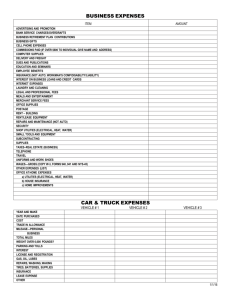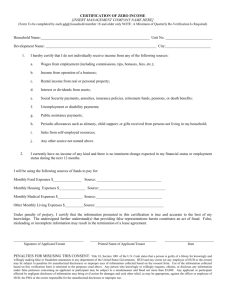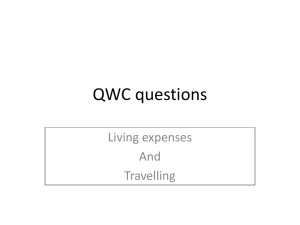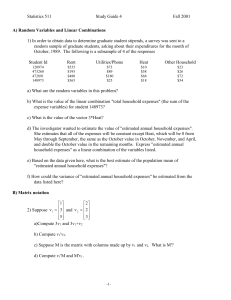Income & Resident Rent Calculation Worksheet
advertisement
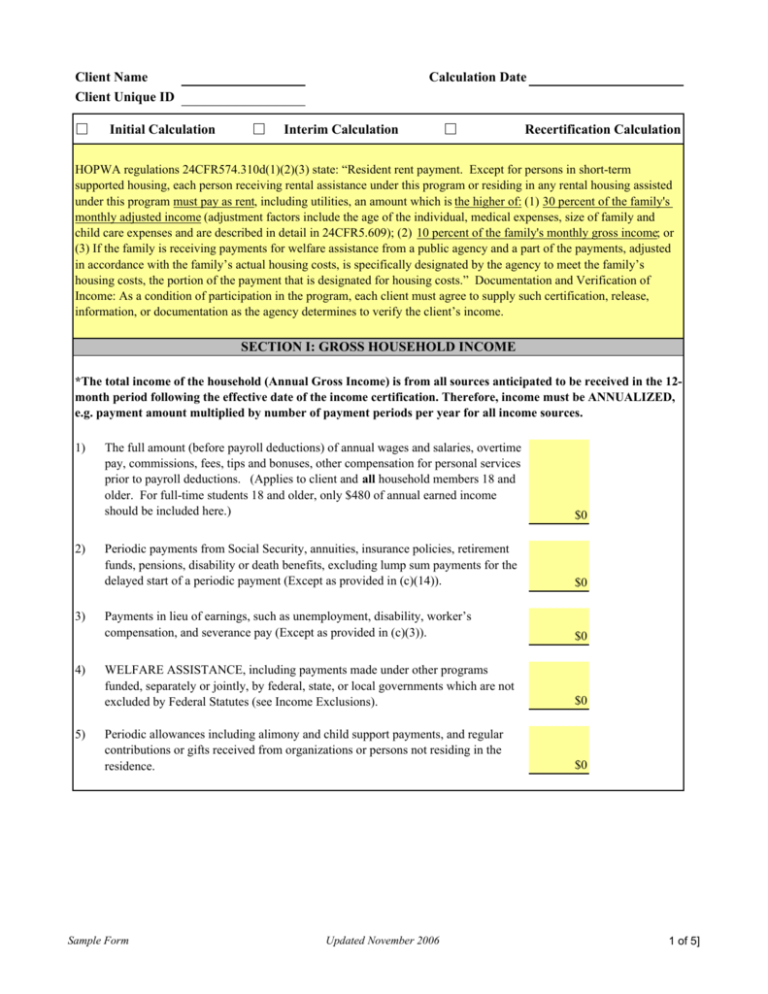
Client Name Calculation Date Client Unique ID Initial Calculation Interim Calculation Recertification Calculation HOPWA regulations 24CFR574.310d(1)(2)(3) state: “Resident rent payment. Except for persons in short-term supported housing, each person receiving rental assistance under this program or residing in any rental housing assisted under this program must pay as rent, including utilities, an amount which is the higher of: (1) 30 percent of the family's monthly adjusted income (adjustment factors include the age of the individual, medical expenses, size of family and child care expenses and are described in detail in 24CFR5.609); (2) 10 percent of the family's monthly gross income; or (3) If the family is receiving payments for welfare assistance from a public agency and a part of the payments, adjusted in accordance with the family’s actual housing costs, is specifically designated by the agency to meet the family’s housing costs, the portion of the payment that is designated for housing costs.” Documentation and Verification of Income: As a condition of participation in the program, each client must agree to supply such certification, release, information, or documentation as the agency determines to verify the client’s income. SECTION I: GROSS HOUSEHOLD INCOME *The total income of the household (Annual Gross Income) is from all sources anticipated to be received in the 12month period following the effective date of the income certification. Therefore, income must be ANNUALIZED, e.g. payment amount multiplied by number of payment periods per year for all income sources. 1) 2) 3) 4) 5) The full amount (before payroll deductions) of annual wages and salaries, overtime pay, commissions, fees, tips and bonuses, other compensation for personal services prior to payroll deductions. (Applies to client and all household members 18 and older. For full-time students 18 and older, only $480 of annual earned income should be included here.) $0 Periodic payments from Social Security, annuities, insurance policies, retirement funds, pensions, disability or death benefits, excluding lump sum payments for the delayed start of a periodic payment (Except as provided in (c)(14)). $0 Payments in lieu of earnings, such as unemployment, disability, worker’s compensation, and severance pay (Except as provided in (c)(3)). $0 WELFARE ASSISTANCE, including payments made under other programs funded, separately or jointly, by federal, state, or local governments which are not excluded by Federal Statutes (see Income Exclusions). $0 Periodic allowances including alimony and child support payments, and regular contributions or gifts received from organizations or persons not residing in the residence. $0 Sample Form Updated November 2006 1 of 5] SECTION I: GROSS HOUSEHOLD INCOME (CONT.) 6) Net income from operation of a business or profession. $0 7) Interest, dividends, and other net income of any kind from real or personal property. Where net family assets are in excess of $5,000, annual income shall include the greater of actual income derived from net family assets or a percentage of the value of such assets based on the current passbook savings rate, as determined by HUD. $0 8) All regular pay, special pay and allowances of a member of the Armed Forces (Except Hostile Fire Pay). $0 9) ANNUAL GROSS INCOME (Sum of lines 1-8) Note: Annual gross income must be reassessed at least annually. However, if there is substantial change in the household’s income during the year, an adjustment must be made to the resident rent to reflect the change in income. $0 10) MONTHLY GROSS INCOME (Line 9 divided by 12.) $0 SECTION II: ALLOWANCES Per HUD regulations 24CFR5.611(a) the annual adjusted income is determined by deducting the following allowances from the annual gross income. 0 11) NUMBER OF DEPENDENTS ($480 for each) Dependents include household members under the age of 18, elderly dependents, handicapped, disabled, or full-time students, but not the family head, spouse or foster children. $0 12) $400 FOR ELDERLY OR DISABLED FAMILY MEMBER This allowance is provided to any family whose head, spouse, or sole member is at least 62 years of age OR is handicapped/disabled. This deduction always applies to households with persons with HIV/AIDS if they are the head, spouse, or sole member at least 62 years of age. (ONLY ONE DEDUCTION PER FAMILY/HOUSEHOLD PER YEAR) $0 13) REASONABLE CHILDCARE EXPENSES (ANNUAL EXPENSE) These are expenses anticipated during the year for children 12 years of age and under that enable a household member to work, seek employment, or to further education. Deductible expenses for childcare to enable a person to work shall not exceed the amount of income received from such work. Childcare cannot be paid to another member of the household. (ONLY EXPENSES NOT REIMBURSED FROM ANY OTHER SOURCES ARE ALLOWED) $0 Sample Form Updated November 2006 2 of 5] SECTION II: ALLOWANCES (CONT.) 14) THE SUM OF THE FOLLOWING EXPENSES, TO THE EXTENT THE SUM EXCEEDS 3% OF ANNUAL GROSS INCOME This deduction may not exceed the earned income received by family members who are 18 years of age or older and who are able to work because of such attendance care or auxiliary apparatus. a) EXPENSES FOR NON-ELDERLY , DISABLED FAMILY MEMBERS $0 This allowance covers reasonable expenses anticipated during the period for attendance care (provided by a non-household member) and/or auxiliary apparatus for any disabled household member that enables that person or any other household member to work. Deduction may not exceed the amount of income generated by the person enabled towork. (ONLY EXPENSES NOT REIMBURSED FROM ANY OTHER SOURCES ARE ALLOWED.) b) MEDICAL EXPENSES AND/OR ASSISTANCE FOR ELDERLY OR DISABLED FAMILY MEMBERS (ONLY EXPENSES NOT REIMBURSED FROM ANY OTHER SOURCES ARE ALLOWED.) $0 15) TOTAL NON-REIMBURSED MEDICAL EXPENSES (Sum of lines 14a and 14b) $0 16) 3% OF ANNUAL GROSS INCOME (Line 9 x .03) $0 17) ALLOWABLE MEDICAL EXPENSE DEDUCTION (Line 16 minus line 17) The Allowable Medical Expense Deduction is the amount of the Total Non-Reimbursed Medical Expenses that exceeds 3% of Annual Gross Income. If result is a negative number, client is not eligible for deduction. $0 Sample Form Updated November 2006 3 of 5] SECTION III: EARNED INCOME DISREGARD (EID) HUD requires disregard for income to previously unemployed persons with disabilities who have earned income as described in 24CFR5.617(a)(b)(c)(d). TO QUALIFY FOR THE EID, THE HOUSEHOLD MUST: a) be a disabled family receiving assistance through HOPWA; SHP; HOME; or the Housing Choice Voucher (Section 8) program; All HOPWA households meet criteria A. X THE HOUSEHOLD MUST ALSO MEET ANY ONE OF THE FOLLOWING: b) A disabled family member's earned income increases as a result of employment, after a period of unemployment of one or more years prior to employment. For local minimum wage: http://www.dol.gov/esa/minwage/america.htm c) A disabled family member's earned income increases as a result of participation in an economic self-sufficiency program or other job-training program d) A disabled family member's income increases as a result of employment during or within six (6) months after receiving assistance, benefits, or services under TANF or a Welfare-to-Work program (including one time only cash asssitance of at least $500. *If the household member qualifies as indicated with an "X" in b, c, or d above, use the formula below to determine how much earned income to disregard. *If a household member does not quality, proceed to section IV. The client may qualify for the Earned Income Disregard for twenty-four (24) months after the effective date of the increase in earned income. For the first twelve (12) months, the entire amount of the increase in earned income may be disregarded. For the second twelve (12) months, 50% of the increase in earned income may be disregarded. Federal regulations limit a qualifying client to a lifetime maximum of 48 months of earned income exclusion. An increase in earned income cannot be disregarded for the purposes of determining clients' initial admission to or eligibility for the TBRA program. Name of Qualifying Family Member Effective Date of Increase in Earned Income a) Current Earned (employment) income of EID family member $0 b) Other Current Income of EID family member $0 c) Total Current Annual Income of EID family member (b+c) $0 d) Pre-Qualifying/Baseline Income (Enter total income including earned and unearned, prior to qualifying event for the EID family member) $0 e) Full Exclusion (Line c - d but no more than a.) If currently in the first 12-month exclusion period enter this amount on line 18. f) 50% Exclusion (Line e divided by 2) If currently in the second 12-month exclusion enter this amount on line 18. 18) EARNED INCOME DISREGARD (Enter applicable figure from either e or f) Sample Form $0 $0 $0 Updated November 2006 4 of 5] SECTION IV: ADJUSTED INCOME 19) ANNUAL GROSS INCOME (from line 9) $0 20) TOTAL ALLOWANCES (Sum of lines 11, 12, 13, 17 and 18) $0 21) ANNUAL ADJUSTED INCOME (Line 19 minus line 20) If result is a negative number, Annual Adjusted Income is $0 $0 22) MONTHLY ADJUSTED INCOME (Line 21 divided 12) If line 21 is a negative number, Monthly Adjusted Income is $0) $0 SECTION V: TENANT RENT PAYMENT� 23) TENANT RENT DETERMINATION a) METHOD 1: 30% OF MONTHLY ADJUSTED INCOME (Line 22 x .30) $0 b) METHOD 2: 10% OF MONTHLY GROSS INCOME (Line 10 x .10) $0 24) TOTAL MONTHLY RENT PER CURRENT LEASE AGREEMENT: Lease Period: $0 25) TENANT RENT: (the higher of line 23a or 23b) $0 26) RENT SUBSIDY PAYMENT: (Line 24 minus line 25) $0 This is the amount the Housing Program pays to Landlord STOP HERE IF: utilities are included as part of the rent charge, this is the total tenant rent and total rent subsidy. CONTINUE IF: tenant must pay utilities out-of-pocket in addition to rent charge. Complete Section VI. SECTION VI: TENANT RENT PAYMENT COMPLETE THIS SECTION ONLY IF THE TENANT'S UTILITIES ARE NOT INCLUDED IN RENT 27) TENANT RENT: (the higher of line 23a or 23b) $0 28) UTILITY ALLOWANCE (if applicable) A tenant is only eligible for a utility allowance if utilities are NOT included in the rent charge. Copies of HUD-approved utility allowance charts may be obtained from local Housing Authorities and are updated periodically. 29) ADJUSTED TENANT RENT PAYMENT (Line 27 minus line 28) $0 $0 THIS IS THE AMOUNT THE TENANT PAYS. IF THIS IS A NEGATIVE NUMBER, THIS IS THE AMOUNT TO BE REIMBURSED TO THE TENANT. THE PROGRAM PAYS THE FULL AMOUNT OF THE RENT (line 24) TO THE LANDLORD. Signature of TBRA Staff Sample Form Date Updated November 2006 5 of 5]


